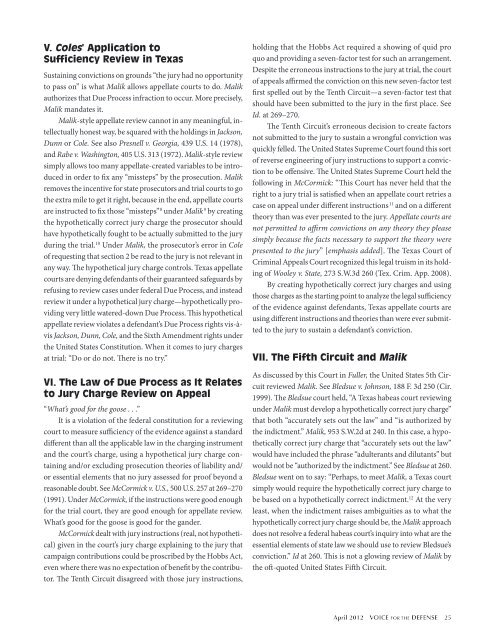for the defense for the defense - Voice For The Defense Online
for the defense for the defense - Voice For The Defense Online
for the defense for the defense - Voice For The Defense Online
You also want an ePaper? Increase the reach of your titles
YUMPU automatically turns print PDFs into web optimized ePapers that Google loves.
V. Coles’ Application toSufficiency Review in TexasSustaining convictions on grounds “<strong>the</strong> jury had no opportunityto pass on” is what Malik allows appellate courts to do. Malikauthorizes that Due Process infraction to occur. More precisely,Malik mandates it.Malik-style appellate review cannot in any meaningful, intellectuallyhonest way, be squared with <strong>the</strong> holdings in Jackson,Dunn or Cole. See also Presnell v. Georgia, 439 U.S. 14 (1978),and Rabe v. Washington, 405 U.S. 313 (1972). Malik-style reviewsimply allows too many appellate-created variables to be introducedin order to fix any “missteps” by <strong>the</strong> prosecution. Malikremoves <strong>the</strong> incentive <strong>for</strong> state prosecutors and trial courts to go<strong>the</strong> extra mile to get it right, because in <strong>the</strong> end, appellate courtsare instructed to fix those “missteps” 8 under Malik 9 by creating<strong>the</strong> hypo<strong>the</strong>tically correct jury charge <strong>the</strong> prosecutor shouldhave hypo<strong>the</strong>tically fought to be actually submitted to <strong>the</strong> juryduring <strong>the</strong> trial. 10 Under Malik, <strong>the</strong> prosecutor’s error in Coleof requesting that section 2 be read to <strong>the</strong> jury is not relevant inany way. <strong>The</strong> hypo<strong>the</strong>tical jury charge controls. Texas appellatecourts are denying defendants of <strong>the</strong>ir guaranteed safeguards byrefusing to review cases under federal Due Process, and insteadreview it under a hypo<strong>the</strong>tical jury charge—hypo<strong>the</strong>tically providingvery little watered-down Due Process. This hypo<strong>the</strong>ticalappellate review violates a defendant’s Due Process rights vis-àvisJackson, Dunn, Cole, and <strong>the</strong> Sixth Amendment rights under<strong>the</strong> United States Constitution. When it comes to jury chargesat trial: “Do or do not. <strong>The</strong>re is no try.”VI. <strong>The</strong> Law of Due Process as It Relatesto Jury Charge Review on Appeal“What’s good <strong>for</strong> <strong>the</strong> goose . . .”It is a violation of <strong>the</strong> federal constitution <strong>for</strong> a reviewingcourt to measure sufficiency of <strong>the</strong> evidence against a standarddifferent than all <strong>the</strong> applicable law in <strong>the</strong> charging instrumentand <strong>the</strong> court’s charge, using a hypo<strong>the</strong>tical jury charge containingand/or excluding prosecution <strong>the</strong>ories of liability and/or essential elements that no jury assessed <strong>for</strong> proof beyond areasonable doubt. See McCormick v. U.S., 500 U.S. 257 at 269–270(1991). Under McCormick, if <strong>the</strong> instructions were good enough<strong>for</strong> <strong>the</strong> trial court, <strong>the</strong>y are good enough <strong>for</strong> appellate review.What’s good <strong>for</strong> <strong>the</strong> goose is good <strong>for</strong> <strong>the</strong> gander.McCormick dealt with jury instructions (real, not hypo<strong>the</strong>tical)given in <strong>the</strong> court’s jury charge explaining to <strong>the</strong> jury thatcampaign contributions could be proscribed by <strong>the</strong> Hobbs Act,even where <strong>the</strong>re was no expectation of benefit by <strong>the</strong> contributor.<strong>The</strong> Tenth Circuit disagreed with those jury instructions,holding that <strong>the</strong> Hobbs Act required a showing of quid proquo and providing a seven-factor test <strong>for</strong> such an arrangement.Despite <strong>the</strong> erroneous instructions to <strong>the</strong> jury at trial, <strong>the</strong> courtof appeals affirmed <strong>the</strong> conviction on this new seven-factor testfirst spelled out by <strong>the</strong> Tenth Circuit—a seven-factor test thatshould have been submitted to <strong>the</strong> jury in <strong>the</strong> first place. SeeId. at 269–270.<strong>The</strong> Tenth Circuit’s erroneous decision to create factorsnot submitted to <strong>the</strong> jury to sustain a wrongful conviction wasquickly felled. <strong>The</strong> United States Supreme Court found this sortof reverse engineering of jury instructions to support a convictionto be offensive. <strong>The</strong> United States Supreme Court held <strong>the</strong>following in McCormick: “This Court has never held that <strong>the</strong>right to a jury trial is satisfied when an appellate court retries acase on appeal under different instructions 11 and on a different<strong>the</strong>ory than was ever presented to <strong>the</strong> jury. Appellate courts arenot permitted to affirm convictions on any <strong>the</strong>ory <strong>the</strong>y pleasesimply because <strong>the</strong> facts necessary to support <strong>the</strong> <strong>the</strong>ory werepresented to <strong>the</strong> jury” [emphasis added]. <strong>The</strong> Texas Court ofCriminal Appeals Court recognized this legal truism in its holdingof Wooley v. State, 273 S.W.3d 260 (Tex. Crim. App. 2008).By creating hypo<strong>the</strong>tically correct jury charges and usingthose charges as <strong>the</strong> starting point to analyze <strong>the</strong> legal sufficiencyof <strong>the</strong> evidence against defendants, Texas appellate courts areusing different instructions and <strong>the</strong>ories than were ever submittedto <strong>the</strong> jury to sustain a defendant’s conviction.VII. <strong>The</strong> Fifth Circuit and MalikAs discussed by this Court in Fuller, <strong>the</strong> United States 5th Circuitreviewed Malik. See Bledsue v. Johnson, 188 F. 3d 250 (Cir.1999). <strong>The</strong> Bledsue court held, “A Texas habeas court reviewingunder Malik must develop a hypo<strong>the</strong>tically correct jury charge”that both “accurately sets out <strong>the</strong> law” and “is authorized by<strong>the</strong> indictment.” Malik, 953 S.W.2d at 240. In this case, a hypo<strong>the</strong>ticallycorrect jury charge that “accurately sets out <strong>the</strong> law”would have included <strong>the</strong> phrase “adulterants and dilutants” butwould not be “authorized by <strong>the</strong> indictment.” See Bledsue at 260.Bledsue went on to say: “Perhaps, to meet Malik, a Texas courtsimply would require <strong>the</strong> hypo<strong>the</strong>tically correct jury charge tobe based on a hypo<strong>the</strong>tically correct indictment. 12 At <strong>the</strong> veryleast, when <strong>the</strong> indictment raises ambiguities as to what <strong>the</strong>hypo<strong>the</strong>tically correct jury charge should be, <strong>the</strong> Malik approachdoes not resolve a federal habeas court’s inquiry into what are <strong>the</strong>essential elements of state law we should use to review Bledsue’sconviction.” Id at 260. This is not a glowing review of Malik by<strong>the</strong> oft-quoted United States Fifth Circuit.
















